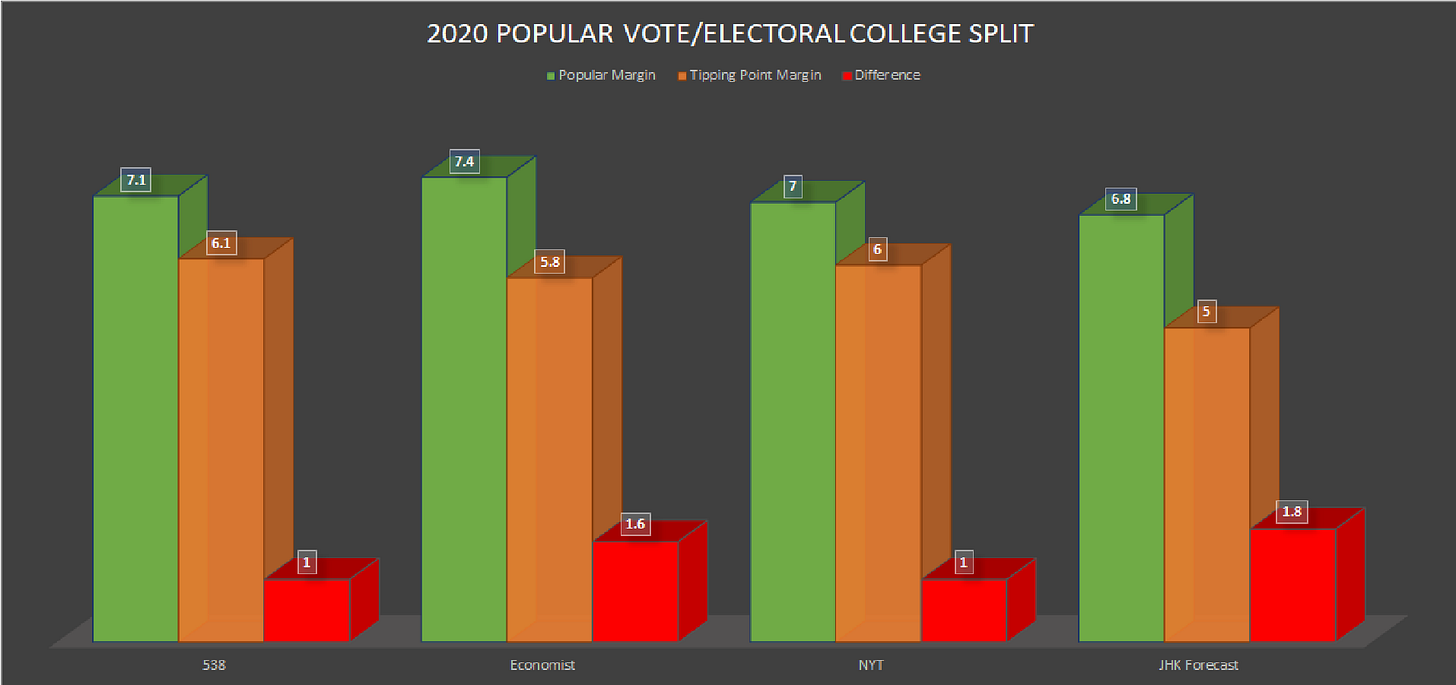2020 Remains Different: Donald Trump May Not Have an Electoral College Advantage
Biden's strength with whites might mean 2016's issue is gone
After Donald Trump won the 2016 election while losing the popular vote, Joe Biden voters fret that pattern will repeat itself in 2020. But Biden’s strength in a series of high-quality polls in the Rust Belt show the electoral college-popular vote split might be minimal.
The easiest way to evaluate if the electoral college is biased toward one candidate is to consider the tipping point state. That state is the one that gives the winning candidate their 270th electoral vote and the presidency. Any state beyond the 270th electoral vote is unnecessary to have won. To determine how the electoral college prefers one candidate, we take the popular vote margin and subtract the margin in the tipping point state.
Here’s an example of the tipping point state v. the electoral college in the last few cycles (blue or red in the final series in each election signifies which party the electoral college favored):

In 2020, Joe Biden has a national polling lead between 6.8 and 7.4 points in the four big national models/averages. In all four, Pennsylvania is the tipping point state. Here’s how those look:

That leaves us with an average tipping point margin of just 1.4 points. Biden voters might reply, “Wait, there’s still an electoral college gap, this is outrageous.” But the gap is only 1.4 points, which is lower than Obama’s edge in 2008 (2.2 points) or 2012 (1.5 points). Trump’s 2.8 point advantage in 2016 was the largest gap between the popular vote and the electoral college since 1948 (4.1 points for Harry Truman).
Some might still protest, “Biden might be doing better than Clinton now, but the polls were wrong last time, so I bet Trump still has held onto his base and will win.” That take belies Biden’s relative strength with white voters.
Trump won white voters in Pennsylvania by 16 points in the 2016 exit polls. He leads with whites by one point in the New York Times/Sienna poll, three points in the Washington Post/ABC poll and six points in the Fox New poll. With those gains among whites, Biden leads by nine points in both the New York Times/Sienna poll and Washington Post/ABC poll. He leads by seven in the Fox News poll.
Biden’s relative strength with white voters has been apparent all year. Amy Walter of the Cook Political Report recently noted—in moving Ohio and Iowa to toss-up status—Biden’s strength white whites in those two states:
The New York Times/Siena College poll (September 16-22) found Trump leading Biden among white, non-college voters by just three-points (44 to 41 percent) — a 20 point drop from 2016. Biden's 41 percent is a six-point improvement on Clinton's showing from 2016.
The Des Moines Register survey (September 14-17), found Biden leading among white, non-college women by 19 points (56 percent to 37 percent), while Trump held a huge 32-point lead with white, non-college men (64 percent to 31 percent). This translates, roughly, to a 7-8 point lead for Trump with these voters, a 14-15 point drop from 2016.
The Monmouth poll (September 18-20), finds Trump only slightly underperforming his 2016 showing with white, non-college voters, leading Biden by 17 points (56 percent to 39 percent); a six-point drop from 2016.
Biden isn’t in the clear, but I argued on Sunday:
Biden and the Democrats could still blow this. The Supreme Court confirmation battle presents a great opportunity to advance their arguments, which are supported by more of the public than the Republicans’ positions. The three debates also give Biden a chance to demonstrate he’s not too far to the left or incapable of handling the demands of the office. But the Big 12’s start to the football season has shown that plenty of favorites can blow leads to troubled opponents.
Biden’s candidacy, so far, has demonstrated his theory about electability is correct. Biden didn’t need to convince new swaths of people to turn out. He just needed to win back some of the Obama-Trump voters to reclaim the Rust Belt; he’s doing that now.
If Biden wins back Michigan, Wisconsin and Pennsylvania—states where Nate Cohn of the New York Times finds he has enough of a lead to sustain a polling error the size of 2016 (and the polls now almost all weigh by education, fixing one of the primary issues in 2016)—he’d win the election. With a win in Nebraska’s Second Congressional District (he leads by seven in the most recent high-quality poll there), Biden could even lose Nevada and New Hampshire and still win:

The easiest take about 2020 is that Trump only won a ridiculously close race in 2016 because he faced a terrible opponent. Now facing a replacement-level opponent, Trump’s devastating personal numbers are too much to overcome. Unless Trump can make Biden an unacceptable alternative in the final 35 days, Biden’s a heavy favorite to win the election.
You can follow Kendall on twitter @kendallkaut. You can subscribe to the newsletter, which will publish at least weekly on the election and politics at https://kendallkaut.substack.com

